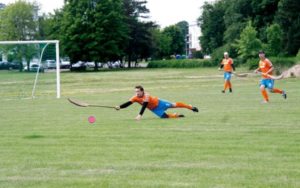Ritinis, sometimes called ripka, is one of the most interesting (authentic) Lithuanian folklore games. It is the only game which was adapted to stadium and turned into a sport. As a game, it was first mentioned in XVII century by S. Daukantas, who extrapolated game’s benefits for physical health and streangth. He wrote that “ritinis is best way of training fighting skills for youngsters”. Ritinis is also mentioned by XVIII century author M. Valančius.
Sports game “ritinis” is named after main playing instrument, a disc shaped object which is thrown by hand in a manner of rolling. In old days it was made out of birch wood and fettered with a metal hoop. The main goal of opponents is to stop thrown disc with a club. Opponents can throw the disc only from the place where it stopped moving. In the past people used to play between villages and the team, whose home village was reached, lost.
Rules of ritinis were adapted to stadium in the year 1923 by Karolis Dineika and the first sports events were held. Then several games were played, but it did not gain popularity. Ritinis was brought back to lifeafter the World War II in year 1956 by Vytautas Steponaitis, a folk games enthusiast, former guerella fighter and USSR deportee. He adapted game rules to football stadium, which made it more popular. Now it is being played by 7 teams in Lithuania.
Nowadays ritinis is played in football stadium or similar sized rectangle site on a grass. It is played between two teams, each of them consisting of 7 players. There are two 20 minute periods/halves. Disc (ritinis) is rolled / thrown by hand and cannot fly in air more than 10-12 meters. A goal is all football stadium back lines, score is when ritinis rolles through it, team gets 1 point. If ritinis is rolled into a goal frame (football gates) 3 points are scored. Ritinis (disc) can only be stopped using clubs. Nowadays disc is made of solid rubber, it is 17 cm in diameter, 2,5 cm thick and weighs 600-700 grams. If ritinis (disc) is rolled by a professional/experienced player it can fly up to 30-35 meters per second.
These are simplified rules of only Lithuanian national sport, which has been played in Lithuania for centuries.

